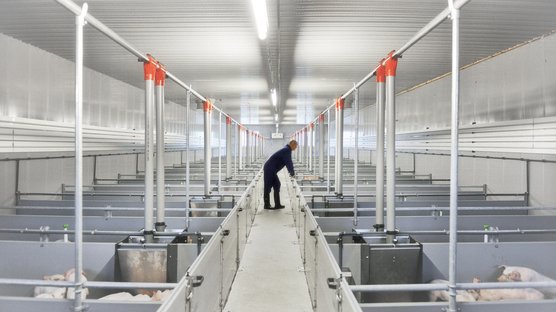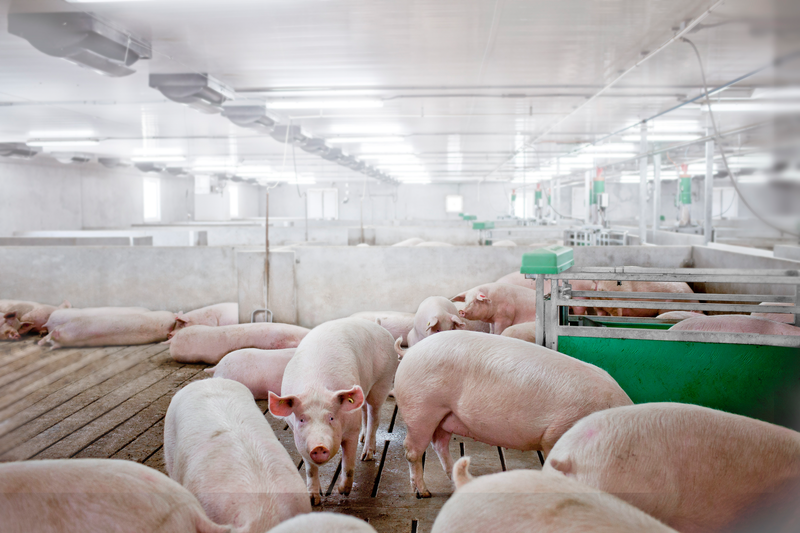
Published on Nov. 9, 2023
The Impact of Genetics on Sow Health and Welfare: Results from the Field
With ongoing genetic selection and the pressure for more piglets, sow survivability has inadvertently been decreasing. This has become a growing challenge in the global swine industry.
Not only are there large economic impacts related to the loss of a productive sow, but herd performance, staff morale¹, and resources used for production are also negatively affected. Ethical and animal welfare concerns are being raised¹ as this increase in sow mortality is seen as unacceptable by both the industry and society. A dead sow in the herd, either unassisted or euthanized, should be considered a failure and a missed opportunity.
There are infectious and non-infectious causes of sow mortality. Infectious causes can be reduced through a high health status, via strict biosecurity protocols and proper individual animal care. Non-infectious causes, in which genetics play an important role, are primarily lameness, prolapse, and factors leading to sudden death. Sow conformation is clearly heritable, but so can be susceptibility to pelvic organ prolapses, intestinal torsions, farrowing ease, or even disease resilience. Sow mortality often involves multiple risk factors and various bacterial agents1, so in addition to better management practices, genetics can also help solve this challenge.
Overview of sow mortality causes within the industry
Sow mortality rates across the industry were estimated at 11-15% in 2022, depending on the database used2,3. They have all had a clear upward trend over the last decade4,5,6. The main reported causes of sow mortality from one large recent study were sudden death (31.2 %), lameness (28.8 %), and prolapse (28.0 %), followed by other causes (12.0 %), (Fig.1)7.
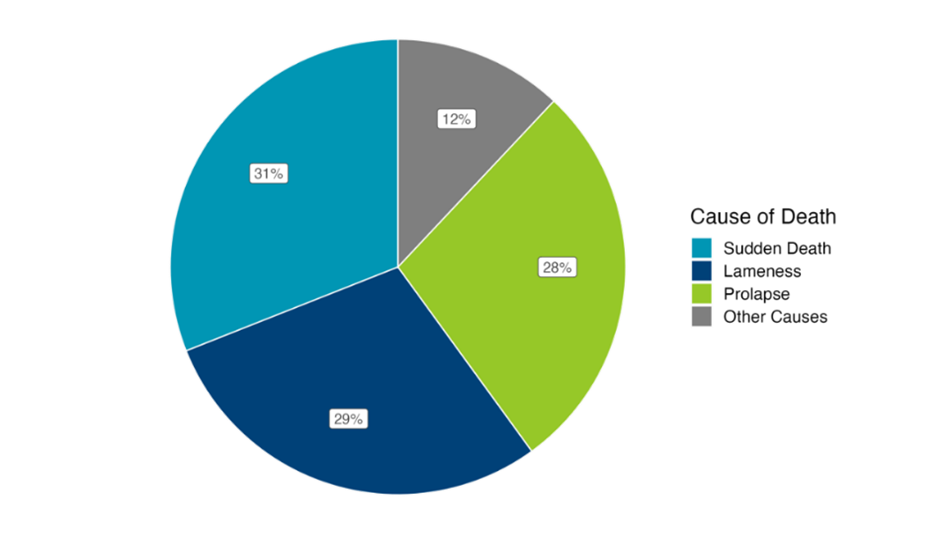
Underlying these causes are primarily non-infectious types of risk factors, many of which are consistently reported in the literature. These include peripartum1 and lactation8 periods, gastrointestinal complications that can lead to ulcers and torsions¹, heat stress8, locomotive problems, body condition¹, and housing systems7,9 There are two high-risk periods of sow death during the production cycle. The highest occurs in the first 10 days postpartum, and the other in prepartum9, right at the end of gestation. Most sudden deaths (53%) and the increasing incidence of pelvic organ prolapses occur in this peripartum period1,10 Thus, the time shortly before, during, and after farrowing is critical11. Young sows (until parity 3) are the main susceptible group, particularly P1 and P2 as they account for about 40% of total sow mortality11. This is unfortunate as it is commonly accepted by the industry that a sow needs to wean 3 litters to pay off her investment. In this group of females, locomotive issues that lead to euthanasia are also a common cause of sow removal. However, the proportion of euthanized sows increases with parity, so older sows tend to be more often euthanized12.
Infectious causes, commonly associated with sow mortality in diagnosed dead sows, are urinary tract infections, endometritis (uterine infections), pneumonia, and chronic diseases. In addition, disease outbreaks, like PRRS, are reported to increase sudden death and weaken sow immunity7,9, exposing them to secondary infections.
Proper sow and herd management is critical to increase sow survivability rates and improve sow welfare¹. Genetics also play an important role. The influence of genetics on susceptibility to pelvic organ prolapse was recently confirmed10. Historically, swine breeders have successfully identified and selected key sow conformation traits over many generations. This has been possible because numerous studies have shown that most conformation and structural traits have moderate heritability, although with some variation from less than 0.1 to more than 0.413,14. Structurally sound animals are more robust, so the importance of genetic selection for these types of traits must not be forgotten and should continue to be investigated.
Genetic impact on sow survivability
The top farms globally using Hypor Libra sows have an average sow survivability rate of >95% (death loss rate of <5%) over the past three years15. The death loss rate (which includes euthanized sows) for all farms in the Americas Libra Benchmark has been 22% lower than the SMS benchmark (i.e., industry) average of 10.6% since 20172,4. The difference between benchmarks has now widened to 3.0 percentage points (pp) over the past two years. Most of this difference occurs in young sows (Fig. 2) which have a 6.5% death loss rate in the industry. This rate is 38% higher than farms using the Hypor Libra. It’s these young sows from other genetic sources that seem to be responsible for an increase in overall sow mortality, due to prolapses and premature lameness.
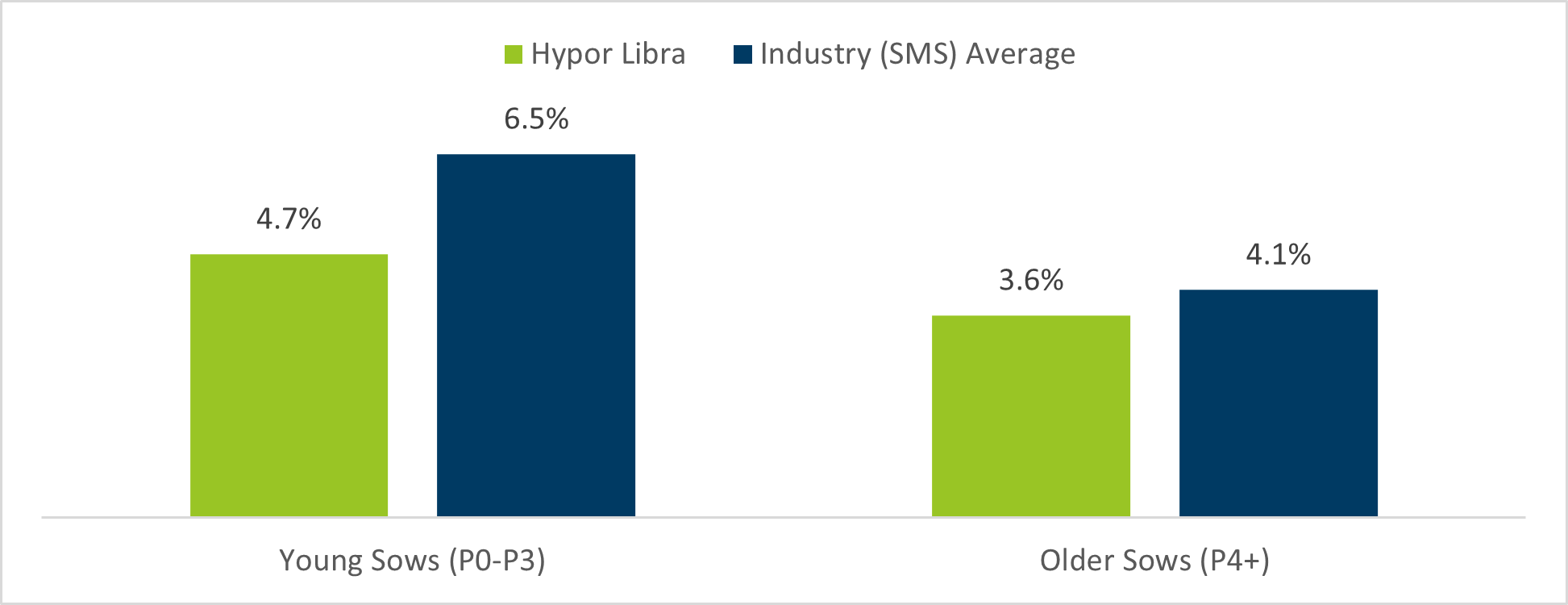
Another industry benchmark shows an even more stark contrast (Fig. 3). A 2021 analysis of the MetaFarms database reported that only 18% of the farms had a sow death loss rate of <8%, but more than a third of the farms had rates of >15%6. For the 2021 Americas Libra Benchmark, most farms had a sow death loss rate below 8% and only 4% of farms surpassed the 15% threshold2. Even a 1pp improvement in sow survivability can have a large economic impact. In-depth analysis at Iowa State University found a 1pp increase in sow survivability translates to savings of $11.40 USD/sow/year16. This equates to $28,490/year on a 2500 head farm. Or, in other words, each dead sow costs $1,140. A similar cost of $992 per dead sow was reported by Ron Ketchem in 202117. The primary underlying costs are loss of piglets, loss of cull sow value, and gilt replacement. Neither of these calculations considered two other costs associated with increased sow mortality as pointed out by Dr. John Deen: A higher proportion of P1 sows and removal of dead sows. P1 sows have poorer farrowing and nursing performance and their progeny have poorer growth performance along with higher mortality. Secondly, physical removal of a dead sow is labor intensive (especially from a stall) and can be emotionally wearing on the workers17.
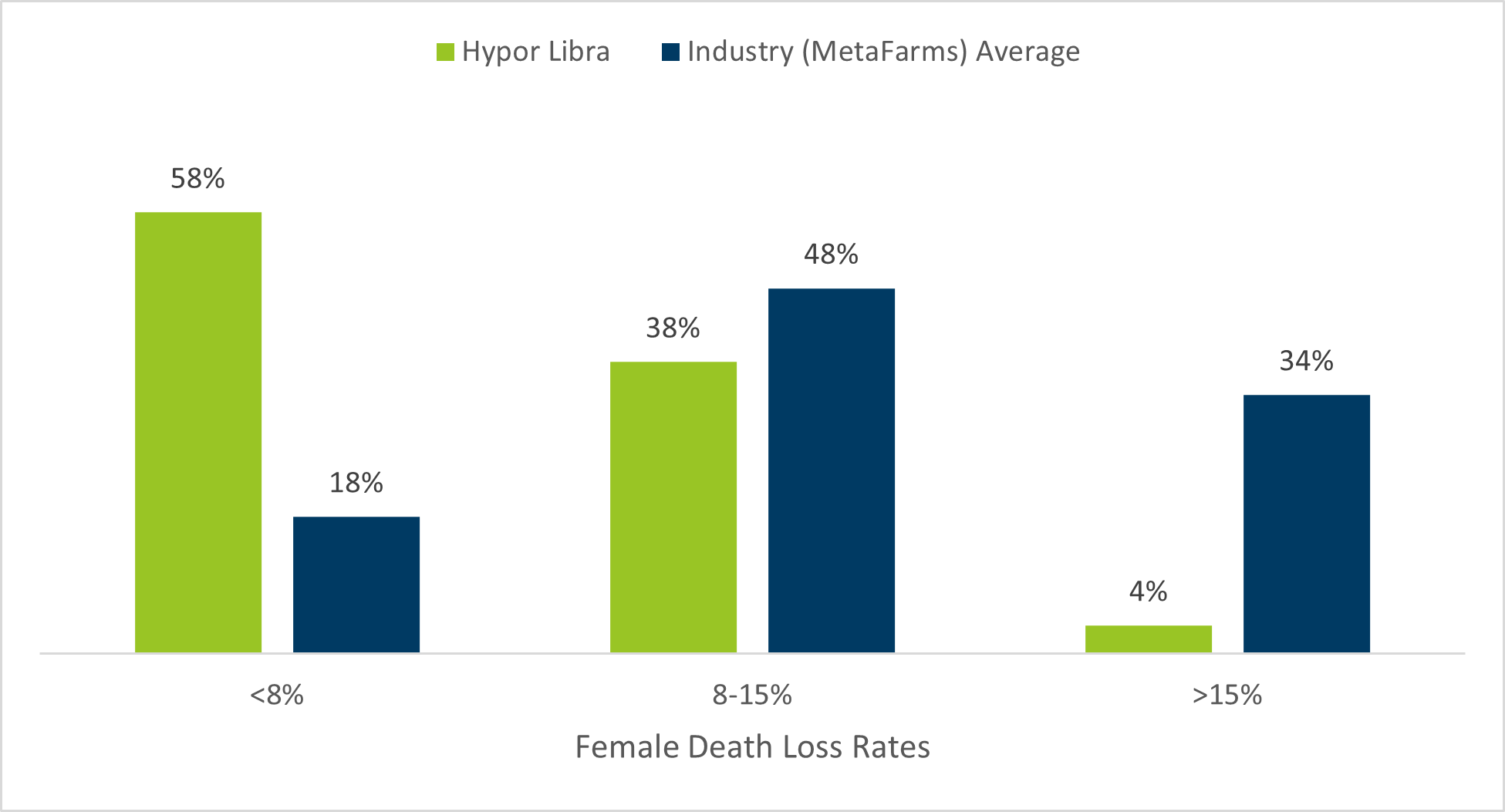
The right genetics and proper herd management with individual animal care go hand in hand to improve sow survivability. A correlation (r) between sows per employee and sow survivability was found to be negative at 0.4318. This suggests additional farm staff (fewer sows per employee) could increase survivability. Of course, acquiring more labor is challenging and costly. Nevertheless, farms with higher rates of sow survivability also tend to have higher rates of piglet survivability (r=0.46) and more piglets weaned per sow per year (r=0.48)19. Farms using the Hypor Libra are not all sufficiently staffed nor do all have ideal herd health and management. Yet their rates of sow survivability are well above the industry average. This is thanks, in part, to Hypor’s balanced and sustainable approach to genetic selection.
Final Words
Hypor, the swine brand of Hendrix Genetics, was the first global animal breeding company to keep their nucleus dam line sows in loose housing. This has provided inherent selection for exceptional feet and leg structure, along with beneficial social behavior. The result is a sociable and calm sow, well suited for all housing systems with superior mobility and survivability. Overall performance has not been compromised. Rather than selecting for ever more total piglets born which can lead to abnormal sow conformation and difficulties in farrowing, the Hypor approach has been to improve survivability for both the piglet and sow, through our 16-15-14 sustainability standard for litter characteristics: 16 total born, 15 born alive, and 14 weaned. All this with minimal intervention and reduced labor. New technologies are also being developed internally to aid in the early detection of sows with locomotive or farrowing issues. Hypor is setting the standard for sustainable swine breeding by using genetic solutions to improve sow survivability to be economically viable, socially acceptable, and environmentally sound.
References
¹ Monteiro et al. 2022. Causes of Sow Mortality and Risks to Post-Mortem Findings in a Brazilian Intensive Swine Production System. Animals. 12, 1804
2 Swine Management Services. 2022-2023. Hypor_ALL_System_Benchmarking 2021-2022. Internal Hypor reports. Unpublished.
3 Farms.com Media & Publishing & PigCHAMP, Inc. 2023. USA and Canada 2022 Year Summary. Benchmark 2023 Spring Edition, p.18-19.
4 Ketchem R.T. and Rix M.D. 2018-2021.!!!!_Hypor_ALL_System_Benchmarking 2017-2020. Internal Hypor reports. Unpublished.
5 Farms.com Media & Publishing & PigCHAMP, Inc. 2018. Canadian and American 2017 Yearend Summary. Benchmark 2018 Spring Edition, p.18-19.
6 Eckberg B. 2022. 2021 Sow mortality analysis. https://www.nationalhogfarmer.com/hog-health/2021-sow-mortality-analysis
7 Paiva et al. 2023. Risk factors associated with sow mortality in breeding herds under one production system in the Midwestern United States. Preventive Veterinary Medicine. Vol. 213
8 Sanz M, Roberts J.D., Perfumo C.J., et al. 2007. Assessment of sow mortality in a large herd. Journal of Swine Health and Production. 15(1):30–36.
9 Kikuti M. et al. 2022. Sow mortality in a pig production system in the midwestern USA: Reasons for removal and factors associated with increased mortality. Vet Rec. e2539.
10 Bathia V. et al. 2023. Identification of the genetic basis of sow pelvic organ prolapse. Front. Genet. 14:1154713
11 Kirk, R.K., Svensmark, B., Ellegaard, L.P., Jensen, H.E., 2005. Locomotive Disorders Associated with Sow Mortality in Danish Pig Herds. Journal of Veterinary Medicine Series A 52, 423-428.
12 Sørensen J.T. and Thomsen R. 2017. Identification of Risk Factors and Strategies for Reducing Sow Mortality. Danish Centre for Food and Agriculture Report Nº097
13 Rothschild M. G. and Christian L. L. 1988. Genetic control of front-leg weakness in Duroc swine. I. Direct Response to five generations of divergent selection. Livestock Production Science. 19:459-471
14 Stadler K.J. et al. 2004. Sow longevity. animalscience.com. Pig News and Information 25 (2). 53N – 74N
15 Vos M. 2021-2023. Global Hypor Libra Reproduction Performance 2020-2022. Internal Hypor reports. Unpublished.
16 Euken R. and Schulz L. 2022. Assessing Economic Opportunity of Improving Mortality Rate in Breed-to-Wean Swine Production. Iowa State University Extension and Outreach. File B1-79.
17 Pig Health Today, Zoetis. 2021. Proceedings Optimum Sow Care: Keys to Improving Well-Being and Longevity. https://pighealthtoday.com/wp-content/uploads/2021/04/Sow-Care-Roundtable-Proceedings-Booklet-hr.pdf
18 Miller E. and DeVries B.2022. 2021 Benchmark Data Export. Internal Hypor report. Unpublished.
19 DeVries, B. 2023. 2020-2022 Benchmark Americas Main Data Internal Hypor report. Unpublished.


